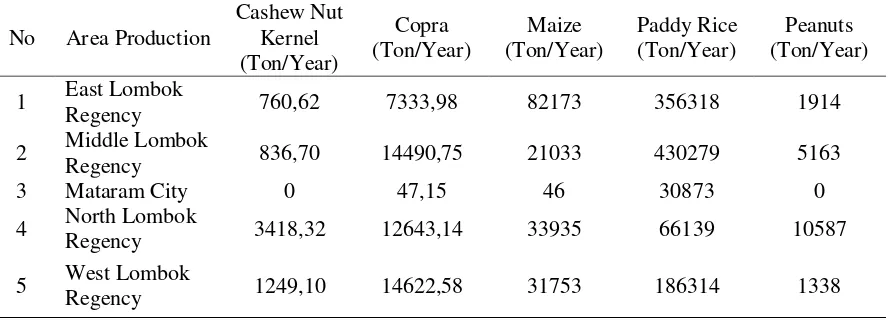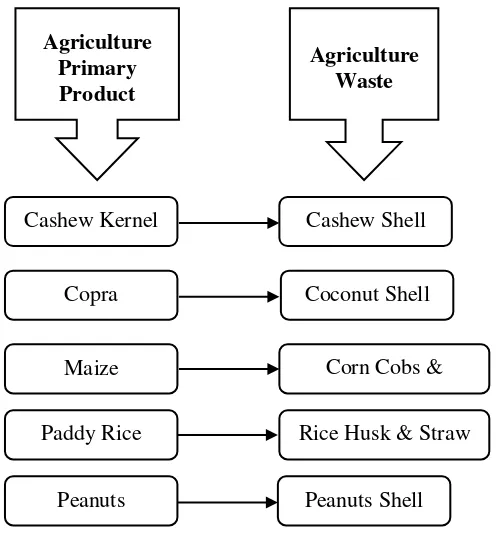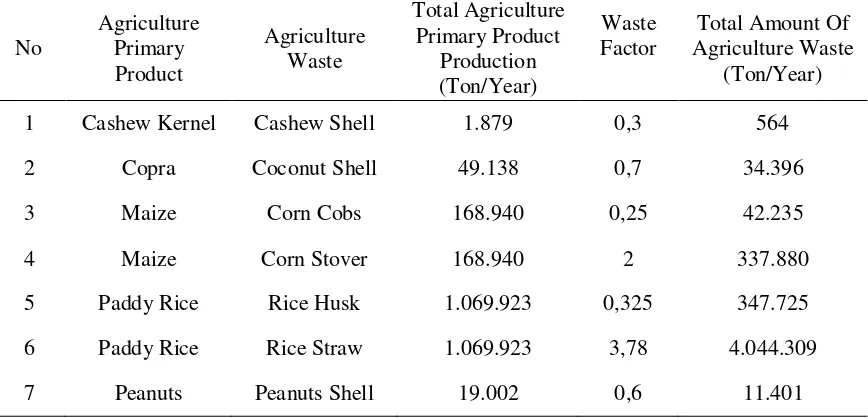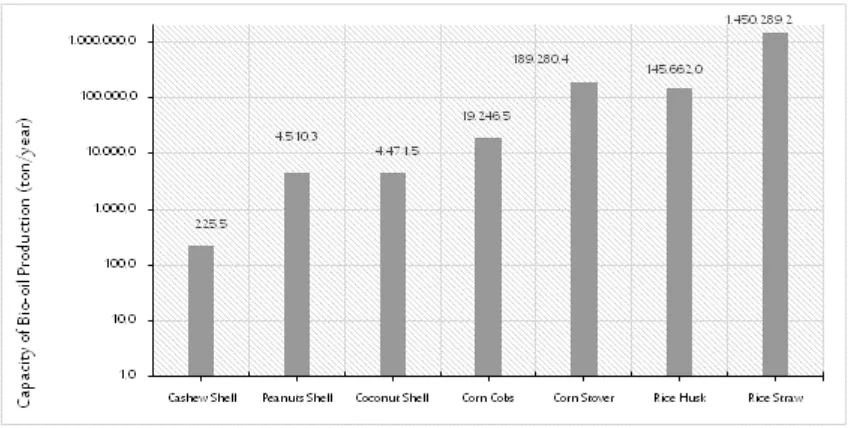BIO FUEL PRODUCTION POTENTIAL FROM AGRICULTURE WASTE IN
LOMBOK ISLAND
Nizar Amir1
1
Department of Agricultural Engineering, Faculty of Food and Agroindustrial Technology, University of Mataram
E-mail: nizaramr@gmail.com
Diterima: 4 Februari 2016 Disetujui: 4 Maret 2016
ABSTRACT
Lombok island faces agriculture waste and energy security problems. The processing of agricultural commodities produces agriculture waste, which can caused serious environmental pollution, but also can be a potential energy source for producing renewable fuel. There is a solution to solve the problems in Lombok Island in term of waste and energy security problems with utilize agriculture waste become bio-oil via pyrolysis process. The bio-oil production potential from agriculture waste such as cashew shell, coconut shell, corn cobs, corn stover, rice husk, rice straw and peanuts shell on Lombok island is investigated in this paper. Based on the collected agriculture waste data from five regencies in Lombok Island, Lombok island can potentially produce 1.813.685,4 ton/year of bio-oil and remove 4.818.510,00 ton/year of agriculture waste every year via pyrolysis process. Maize and paddy rice are the most favorable bio-oil production source in Lombok Island. Based on this investigation, it was concluded that the production of bio-oil from agriculture waste is suitable to apply in Lombok Island. For reaching the goal, the government must support these type of projects and provide some good policies for renewable fuel production.
Keywords: agriculture, bio fuel, waste
INTRODUCTION
Lombok Island is a small island with an area of 4738.7 km2, which more than 60% of the areas utilize agriculture sector. Agriculture is one of the important sectors in Lombok Island; paddy rice, maize, coconut and cashew are some of the largest agriculture products produced every year in Lombok island. The Agriculture waste from this sector is huge, where small amount of agriculture waste was recycled then the rests were thrown away. These unprocessed agriculture waste made an environmental problems, however recycled waste still have a problem if used for burning purposes. Since the energy crisis year, the energy utilization from agriculture waste has been received special attention, Agriculture waste contains a huge amount of organic matter and classified a high energy content (Omer, A.M., 2005). Utilizing this energy does
give advantages when implemented on Lombok Island.
Potential of Bio Fuel Production From Agriculture Waste in Lombok Island
Lombok island produced more than 6.265 [Ton/Year], 49.138 [Ton/Year], 168.940 [Ton/Year], 1.069.923 [Ton/Year] and 19.002 [Ton/Year] of cashew kernel, copra, maize, paddy rice and peanuts, respectively, the details of the production are presented in Table 1.
Table 1. Several agriculture commodity production in Lombok Island (Nusa Tenggara Barat in Figures, 2014)
No Area Production
Cashew Nut Kernel (Ton/Year)
Copra (Ton/Year)
Maize (Ton/Year)
Paddy Rice (Ton/Year)
Peanuts (Ton/Year)
1 East Lombok
Regency 760,62 7333,98 82173 356318 1914
2 Middle Lombok
Regency 836,70 14490,75 21033 430279 5163
3 Mataram City 0 47,15 46 30873 0
4 North Lombok
Regency 3418,32 12643,14 33935 66139 10587
5 West Lombok
Regency 1249,10 14622,58 31753 186314 1338
North Lombok, West Lombok, East Lombok and Middle Lombok are the major agricultural production regencies for cashew kernel and peanuts, copra, maize and paddy rice, respectively, consequence those regencies produced a huge amount of agricultural waste from their agriculture production. These huge
amounts of agriculture waste could be considered as a potential source of renewable fuel production via pyrolisis process. Pyrolysis is thermal decomposition occurring in the absence of oxygen, three products are usually produced: gas, pyrolysis oil (bio-oil) and charcoal as shown in Figure 1.
Figure 1. Products from pyrolysis conversion Agriculture
Waste
Pyrolysis process
Charcoal
Bio-oil
Gas
Biofuel Feed
Product
Conversion Process
Product Output
The pyrolysis production may varied by several conditions, in one hand, lower process temperatures and longer vapour residence times tend to produce charcoal, in the other hand, high temperatures and longer residence times increase biomass conversion to gas, however moderate temperatures and short vapour residence time are optimum for producing liquids (Bio-oil). Apply pyrolysis technology on Lombok Island to produce bio-oil from agriculture waste has several
advantages and disadvantages. Reduces greenhouse gas emissions and agriculture waste going to landfill, produces a marketable product (biofuel), low risk of water pollution, low risk of odours, minimal risk of health consequences and it can substitute fossil fuels in heat and power applications are the main advantages. However, technology is still evolving, high initial investment and development made pyrolysis need more attention to grow.
Figure 2. Agriculture product and their waste
The bio-oil contains hundreds of organic compounds that belong to alkanes, aromatic hydrocarbons, phenol derivatives and little amounts of ketones, esters, ethers, sugars, amines and alcohols with H/C molar ratio higher than 1.5 (Lu Q et al., 2009). Bio-oil is promising for substitute the fossil fuel because bio-oil flames are shorter, wider and brighter than fossil fuel flames at the same conditions and low calorific value (Stamatov et al., 2006).
Basic data for bio-oils and fossil fuels are compared in Table 2.
The agriculture waste from primary products such as cashew kernel, copra, maize, paddy rice and peanuts are the potential
feedstock for bio oil production in Lombok Island. After harvesting process, the primary products produce waste, such as cashew shell, coconut shell corn cobs and stover, rice husk and straw and peanuts shell as shown in Figure 2. An investigation made on the total amount of agriculture waste that produces from agriculture activities in Lombok Island shows that over 4,8 million tonnes of agriculture waste are generated annually, with high potential feedstock for produce bio-oil from cashew shell (564 tonnes), coconut shell (34.396 tonnes), corn cobs (42.235 tonnes) , corn stover (337.880 tonnes), rice husk (347.725 tonnes), rice straw (4.044.309 tonnes) Agriculture
Primary Product
Cashew Kernel
Copra
Maize
Paddy Rice
Peanuts
Agriculture Waste
Cashew Shell
Coconut Shell
Corn Cobs & Stover Stover
Rice Husk & Straw
and peanuts shell (11.401 tonnes) as presented in Table 3.
Table 2. Typical properties of Wood Pyrolysis Bio-oil and Heavy Fuel Oil (Czernik,S and Bridgwater, A.V)
Physical Propertiess Bio-oil Fossil
Fuel
Moisture Content (wt%) 15 - 30 0,1
pH 2,5 -
Specific Gravity 1,2 0,94
Elemental Composition (wt%)
C 54 - 58 85
H 5,5 – 7,0 11
O 35 - 40 1,0
N 0 - 0,2 0,3
Ash 0 - 0,2 0,1
HHV (MJ/kg) 16 - 19 40
Viscosity, at 500 oC (cP) 40 - 100 180
Solid (wt%) 0,2 - 1 1
Destilation Residue (wt%) Up to 50 1
Table 3. Agriculture waste potential
No
Agriculture Primary Product
Agriculture Waste
Total Agriculture Primary Product
Production (Ton/Year)
Waste Factor
Total Amount Of Agriculture Waste
(Ton/Year)
1 Cashew Kernel Cashew Shell 1.879 0,3 564
2 Copra Coconut Shell 49.138 0,7 34.396
3 Maize Corn Cobs 168.940 0,25 42.235
4 Maize Corn Stover 168.940 2 337.880
5 Paddy Rice Rice Husk 1.069.923 0,325 347.725
6 Paddy Rice Rice Straw 1.069.923 3,78 4.044.309
Figure 3. Oil Yield (%wt) produced from agriculture waste via pyrolysis process
The percentage of bio-oil production during the pyrolysis process from agriculture waste are presented in Figure 3 (Das, P and Hanesh, A., 2003), (Tsai et al., 2006), (Mullen et al., 2010), (Putun et al., 2004), (Zheng, J.L., 2007), (Zhang et al., 2011). Figure 4 shows the bio-oil production from several agriculture waste in Lombok Island and the total potential can be 1.813.685,4 ton/year. Waste from maize and paddy rice are the best potential for producing bio-oil in Lombok Island.
Figure 4. Major agriculture waste for production of bio-oil in Lombok Island
DISCUSSION AND CONCLUSIONS
At the moment, Lombok Island faces the biggest problems in waste and energy security problems. Unprocessed agricultural waste has caused serious environmental pollution, such as water contamination, odor problems and source of diseases in Lombok
Island, but it can be the best solution to enhance the energy security, that still depends on fossil fuel, and also will contribute to decrease environmental problems because of agriculture waste. From this investigation it has been known that Lombok Island has great potential to produce bio-oil from agriculture waste.
From five regencies area in Lombok Island are estimated to be potentially produced 1.813.685,4 tons/year of bio-oil every year. Middle Lombok Regency is the best location to start the investment because it produce high amount of agriculture waste, located in the heart of Lombok Island and easy to transport the feedstock from around Lombok Island. The land price still low and good infrastructure are the promising points to develop the power plant.
Maize and paddy rice are the most favorable bio-oil production source in Lombok Island. Based on this investigation, it was concluded that the production of bio-oil from agriculture waste is suitable to apply in Lombok Island, especially in Middle Lombok Regency. For reaching the goal, the government must support these type of projects and provide some good policies for renewable fuel production.
REFERENCES
Czernik, S and Bridgwater, A.V. 2004. Overview of Applications of Biomass Fast Pyrolysis Oil. Energy & Fuel. Vol 18: 590-598.
Demirbas, A. 2004. Combustion
Characteristics of Different Biomass Fuels. Progress in Energy and Overview of Fuel Properties of Biomass Fast Pyrolysis Oils. Energy Conversion
and Management. Vol 50 (5): 1376-1383.
Mullen, C.A, Boateng, A.A, Goldberg, N.M, Lima, I.M, Laird, D.A and Hicks, K.B. 2010. Bio-oil and Bio-char Production from Corn Cobs and Stover by Fast Pyrolysis. Biomass and Bioenergy. Vol 34: 67-74.
Nusa Tenggara Barat in Figures. 2014. BPS Catalog: 1102001.5.
Omer, A.M. 2005. Biomass Energy Potential and Future Prospect in Sudan. Renewable and Sustainable Energy Reviews. Vol 9:1–27.
Putun, A.E, Apaydin, E and Putun, E. 2004. Rice Straw as a Bio-oil Source via Pyrolysis and Steam Pyrolysis. Energy. Vol 29: 2171-2180.
Stamatov, V, Honnery, D and Soria, J., 2006. Combustion Properties of Slow Pyrolysis Bio-oil Produced from Indigenous Australian Species. Renewable Energy. Vol 31: 2108-2121.
Tsai, W.T, Lee, M.K and Chang, Y.M. 2006. Fast Pyrolysis of Rice Straw, Sugarcane Bagasse and Coconut Shell in an Induction-Heating Reactor. Journal of Analytical and Applied Pyrolisis. Vol 76: 230-237.
Zhang C, Zhang R, Li X, Li Y, Shi W, Ren X and Xu X. 2011. Bench-Scale Fluidized-Bed Fast Pyrolysis of Peanut Shell for Bio-Oil Production. Environmental Progress & Sustainable Energy. Vol 30, No. 1.



